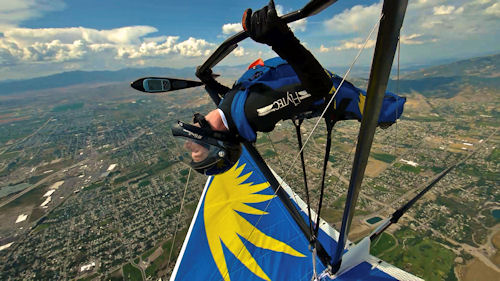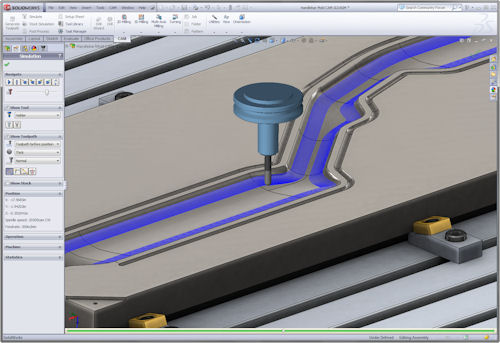Latest News
July 2, 2012
By Mark Clarkson

Consider the modern hang glider, a flexible, triangular, two-lobed wing with the same area—around 150 sq. ft.—as a two-seater Cessna. Hanging beneath it: nothing but you.
“It’s the only kind of flying where you feel like a bird,” says hang gliding enthusiast Steve Pearson. “In hang gliding, the wings are yours. The control mechanism is really quite remarkable. Displacing your weight changes the flexibility of the membrane, and initiates a turn in a very complicated way that could only have evolved by iterative development over many, many years.”
Pearson knows of what he speaks. He’s not just a hang gliding enthusiast, he is also the chief designer and engineer at Wills Wing, considered to be the world’s leading hang glider manufacturer. Well, truthfully, he’s the only engineer—the company, which makes 650 gliders a year, only employs about 20 people.
The History of Hang Gliding
Hang gliders have been around in some form since at least the 1880s. What we think of as a modern hang glider—a triangular, two-lobed kite—was first flown in 1961. By 1976, the sport had really “taken off,” with as many as 100 hang glider manufacturers. Many of them worked out of their garages and used materials ranging from plastic to bamboo. But there were, perhaps predictably, dozens of fatal accidents every year that influenced public perception of the sport.
“When we took over Wills in 1977,” says Pearson, “the major manufacturers were developing air worthiness and stability standards, to provide some measure of safety. In the intervening years, hang gliders have evolved far past what most people conceive.”
Although there are only a handful of manufacturers, today’s hang gliders are sophisticated machines made from cutting-edge materials—lightweight, safe, maneuverable engineering marvels that can glide or race between thermals for hundreds of miles. Wills’ hang gliders are made of 7075 seamless aluminum, carbon fiber and high-strength polyester film.
Safety in the sport has also soared: Fatalities have dropped well below one in 100,000 flights.
How Hard Can it Be?
Pearson has been using SolidWorks for his designs since 1995, but, until five years ago, the actual parts were built elsewhere. Wills Wing is situated in Orange County, CA, with access to plenty of machine shops.
“I have three different machine shops that I work with,” says Pearson. “They each are really good at different types of projects. They also have different cost points. When I was designing components, I would typically design the component with ]a particular] shop in mind.”
And then came “the part that changed everything.”
“I designed this part for machinist A,” says Pearson. “For whatever reason, he couldn’t make it. So I redesigned it for machinist B and, for whatever reason, that didn’t work out. This part was a key component of a new product release, so the clock was ticking as I went through these redesigns.”
Pearson ended up redesigning it for machinist C, who could make it. But the cost, delay and the end result still not being what he had in mind took Pearson to the boiling point: “At that point I thought, ‘I’m just going to do this myself. How hard can it be?’”
Leap of Faith
“For a little company, deciding to buy a ]computer numerical control] CNC machine, learn how to program it, and start making our own parts required a big leap of faith,” says Pearson. “But once we made our first part, there was no looking back,” he says. “Now, when I design a part, I design it the way I want it to be.”
Wills initially purchased a standalone CAM application.
“I understood all the advantages of having integrated applications, but I was too cheap,” Pearson admits. The standalone CAM application required Pearson to export designs from SolidWorks, import them into Rhino, and then export them again from Rhino to CAM.
“I knew I didn’t have the associativity,” he says. “If I changed something, I would have to do the whole process over again.”
License for Success
Eventually, Pearson became frustrated with his standalone CAM application. When he saw the product release for HSMWorks, he followed up on it. The reseller gave him a 30-day trial license.
It wasn’t quite love at first sight.
“My initial impression,” says Pearson, “was that ]HSMWorks] wasn’t very powerful, because there weren’t as many icons and buttons and widgets. I thought, what can I do with this? Where’s all the stuff? But when you start working on a part, you realize that it’s very intuitive. If you know SolidWorks, you know HSMWorks.”
Pearson was particularly pleased with the post processor because he no longer has to modify his posts. He also likes how fast the program is at calculating paths: “I called the reseller three days later and said, ‘Sign me up.’”
Unexpected Benefits
Wills has realized some unexpected benefits from bringing more of their manufacturing in-house, says Pearson. “There’s a transaction cost with all of these parts that I hadn’t considered. A machine shop may be able to manufacture the part, and the raw machining costs might be a little cheaper than ]mine], but that’s before you include the communications dealing with the outside vendors, and the lead times, and the quantity requirements.
“Typically, machine shops want to make parts in even numbers—100 or 500 or 1,000. I want to make 53, because I have 106 components that match with it in pairs.”
This isn’t just Pearson being contrary. With 13 different models, each with hundreds of parts, inventory management represents a big part of Wills’ overhead.
 |
| Working on a handlebar in HSMWorks. |
“Now I make just what I want, in the quantity I want,” he says. “Our process has become much leaner, and the quality of our products is better. We don’t have inspection issues with parts coming in, because they’re inspected as they’re made.”
Pearson has found himself making entirely new things. In the age of social media, Wills wants to see photos and videos of people enjoying their products all over the Internet.
“Everybody’s big on GoPro ]cameras],” he says, “but there was no convenient way to mount one to our hardware. So I designed this little GoPro bracket that mounts on our hang glider. I made 50 of them, and just gave them away to people who I know are going to make great photos. If I couldn’t just do it myself, I wouldn’t bother.”
Product Differentiator
Wills still sends some parts out for manufacture, especially large runs of common parts, says Pearson, but CAM and in-house manufacturing has been a major product differentiator for them.
“Having the capability to improve our product and make changes in-house has been a significant factor,” he says. “Our competition doesn’t have this capability. A lot of their components are cast, and they’re structurally and cosmetically inferior. The customers recognize the difference.”
Contributing Editor Mark Clarkson is DE’s expert in visualization, computer animation, and graphics. His newest book is Photoshop Elements by Example. Visit him on the web at MarkClarkson.com or send e-mail about this article to [email protected].
More info
Subscribe to our FREE magazine, FREE email newsletters or both!
Latest News
About the Author
Mark ClarksonContributing Editor Mark Clarkson is Digital Engineering’s expert in visualization, computer animation, and graphics. His newest book is Photoshop Elements by Example. Visit him on the web at MarkClarkson.com or send e-mail about this article to [email protected].
Follow DE





